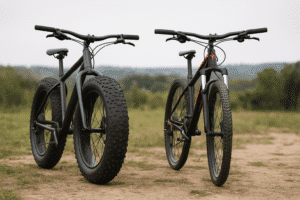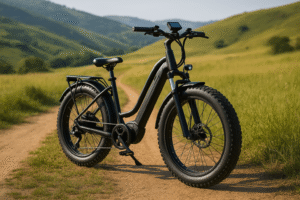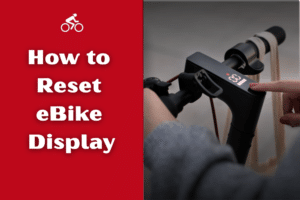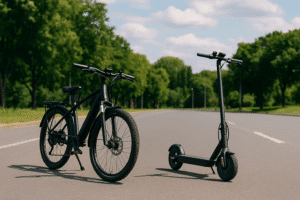E-bike ownership has exploded in the U.S., with over 1.1 million units sold in 2022, nearly four times the sales of 2019. By 2024, e-bikes were outselling electric cars in total units, and about 15% of Americans report owning or regularly using one.
Learning how to maintain your e-bike the right way can keep it running smoothly for years, saving you money on repairs and improving your overall riding experience.
Key Summary:
To maintain your e-bike, keep it clean, check the brakes, lube the chain, and store the battery at around 50–60% charge in a cool, dry place. Regular upkeep extends its life and prevents costly repairs.
Why E-Bike Maintenance is Important
Taking care of your e-bike isn’t just about making it last longer; it also makes your rides safer and more enjoyable. A well-maintained e-bike runs smoother, responds better, and doesn’t surprise you with sudden breakdowns.
Here’s why regular maintenance matters:
- Saves You Money: Replacing a worn-out battery or motor is expensive. Simple maintenance can help you avoid those costly fixes.
- Improves Performance: A clean and well-lubricated drivetrain gives you a smoother ride, while properly inflated tires improve efficiency.
- Keeps You Safe: Worn-out brakes, loose bolts, or frayed wires can be dangerous. Checking these regularly helps prevent accidents.
- Extends Battery Life: Proper charging habits and storage conditions can keep your battery running strong for years.
- Prevents Unexpected Breakdowns: There’s nothing worse than getting stranded miles from home because of something that could have been avoided with a quick check.
How to Maintain Your E-Bike
Here’s how to maintain your electric bike to keep it running smoothly, extend its lifespan, and avoid costly repairs:
- Clean and inspect your e-bike regularly
- Charge and store the battery properly
- Check motor and electrical connections
- Maintain proper tire pressure
- Clean and lubricate the chain
- Inspect and adjust the brakes
- Update software and reset when needed
| Task | Frequency | What to Check |
|---|---|---|
| Clean and inspect | After every ride | Frame, chain, and electrical connectors |
| Lubricate chain | Every 2–3 weeks | Clean old lube before reapplying |
| Battery check | Monthly | Charge level, corrosion, and storage temp |
| Brake inspection | Every 1–2 months | Pad thickness and cable tension |
| Software updates | Every 3–6 months | App and firmware |
1. Clean and Inspect Your E-Bike Regularly
I can’t tell you how many times I’ve seen people ride their e-bikes through mud and then just park them, letting the dirt cake onto everything. That grime isn’t just ugly; it can wear down parts faster and mess with electrical connections. A clean e-bike lasts longer and rides better.
Give your e-bike a quick wipe-down after every ride, especially if you’ve been through rain or dusty trails. A deep clean once in a while helps prevent rust and keeps moving parts from wearing out too soon.
How to clean your e-bike properly:
- Skip the pressure washer. Water can seep into the motor and battery, causing damage. Use a damp cloth instead.
- Use mild soap and a soft brush. A toothbrush works great for getting into small spaces.
- Clean the chain separately. Use a degreaser and a rag to wipe off old lubricant and dirt before applying fresh lube.
- Dry everything well. Water left on the frame or components can cause rust.
2. Charge and Store the Battery Properly
Your battery is the most expensive part of your e-bike, so treating it right is key. Most e-bike batteries last around 3-5 years, but with proper care, you can stretch that lifespan even longer.
One of the biggest mistakes people make is leaving their battery plugged in overnight or draining it completely before charging. Batteries like to stay in the middle range—so avoid extreme highs and lows.
If you’re storing your e-bike for a while, don’t just leave the battery in the bike at 100%. A partially charged battery (around 50-60%) kept in a cool, dry place will last much longer.
Also, keep the battery contacts clean; a quick wipe with a dry cloth now and then helps avoid connection issues.
3. Check Motor and Electrical Connections
E-bike motors are built to last, but they still need some attention. Most issues come from water exposure, loose connections, or overheating. If you ride in wet conditions, dry your motor and electrical components after each ride.
Things to check regularly:
- Inspect wires and connectors. Look for frayed or loose cables, as these can cause power issues.
- Keep the motor area clean. Wipe off dust and debris, especially around vents.
- Listen for unusual noises. Clicking or grinding sounds could mean something is off inside the motor.
4. Maintain Proper Tire Pressure
I’ve learned the hard way that riding with low tire pressure makes pedaling way harder and increases the risk of flats. Keeping your tires properly inflated helps your e-bike roll more efficiently and prevents unnecessary wear.
Tire maintenance tips:
- Check tire pressure at least once a week. Use a pressure gauge to match the recommended PSI on the tire sidewall.
- Inspect for cracks, punctures, or worn tread. If you see thin spots or bald areas, it’s time for new tires.
- Rotate your tires occasionally. This helps them wear evenly, especially if you carry heavy loads.
5. Clean and Lubricate the Chain
A dry, squeaky chain is a sign of trouble. The chain and gears are the hardest-working parts of your e-bike, and without regular maintenance, they wear out fast. A clean, well-lubricated chain keeps your ride smooth and extends the life of your entire drivetrain.
I make it a habit to clean and lube my chain every couple of weeks (or sooner if I ride in wet conditions). A little effort here saves a lot of money down the road.
Use a chain checker tool every few months to see if your chain is stretching. If it is, replace it before it starts wearing down your cassette and chainring, which are more expensive to fix.
6. Inspect and Adjust the Brakes
Your brakes are your best friend when it comes to safety. Worn-out brake pads or loose cables can make stopping harder, which is the last thing you want when riding at high speeds.
Brake maintenance tips:
- Check brake pads for wear. If they look thin or feel weak, replace them.
- Clean brake rotors or rims. Use rubbing alcohol and a clean rag to wipe off dirt and oil buildup.
- Adjust brake levers and cables. If your brakes feel spongy or unresponsive, they may need tightening.
7. Update Software and Reset When Needed
Most modern e-bikes have smart controllers or apps that help monitor battery life, motor efficiency, and performance. Keeping the software up to date can fix bugs and improve efficiency.
If your e-bike has an app, check for firmware updates regularly. Manufacturers often release updates that optimize power usage, improve range, or fix minor glitches.
Sometimes, a quick reset of the Battery Management System (BMS) can fix power issues. If your battery suddenly stops working, disconnect it for a few minutes and reconnect—it might just need a reset.
How to Properly Store Your E-Bike

Storing your e-bike the right way keeps it in good shape, whether you’re parking it for the night or leaving it untouched for months. Where and how you store it can affect battery life, tire condition, and overall performance. Here’s how to do it right.
Short-Term Storage
If you’re riding your e-bike regularly, short-term storage is all about convenience while keeping it safe from the elements.
- Keep it dry and protected. Store your e-bike indoors or under a cover to prevent rust and weather damage.
- Park it upright. Leaning it against a wall can put stress on one side. Use a sturdy kickstand or a bike rack.
- Avoid extreme temperatures. Leaving your e-bike in direct sunlight or freezing cold can wear out the battery faster.
- Charge the battery regularly. If you ride daily, topping up the battery after each ride helps maintain performance.
Long-Term Storage
If you’re not riding for weeks or months, a little extra care can keep your e-bike from developing problems while it sits.
- Partially charge the battery. Store it at around 50-60% charge. A fully charged or completely drained battery can degrade faster.
- Remove the battery if possible. Storing it separately in a cool, dry place can prevent power loss and damage.
- Elevate the tires. If the bike is sitting for months, keep the tires off the ground to avoid flat spots.
- Lubricate the chain and moving parts. This prevents rust from forming while the bike is not in use.
- Check it periodically. Even in storage, do a quick check every few weeks to make sure everything looks good.
Common Electric Bike Issues and Troubleshooting
Even with good maintenance, e-bikes can run into issues. The good news is that many problems have simple fixes. Here are some common ones and what you can do about them.
Battery Won’t Charge
A non-charging battery can be frustrating, but it doesn’t always mean the battery is dead.
- Check the charger. Try plugging it into a different outlet or using another charger to see if that’s the issue.
- Inspect the battery contacts. Dirty or corroded connectors can prevent charging. Clean them with a dry cloth.
- Reset the Battery Management System (BMS). Some batteries need a reset if they’ve been completely drained. Try disconnecting and reconnecting it after a few minutes.
- Temperature matters. If it’s too hot or too cold, the battery may refuse to charge. Let it reach room temperature before trying again.
Motor Cutting Out While Riding
If your e-bike motor stops working mid-ride, don’t panic. It’s usually an easy fix.
- Check for loose connections. Bumpy rides can shake wires loose. Make sure everything is plugged in securely.
- Look at the battery level. If the battery is running low, the motor may stop working to protect the system.
- Overheating protection. If you’ve been riding uphill or at high speeds for a long time, the motor might shut down to cool off. Let it rest before restarting.
E-Bike Won’t Turn On
When your e-bike refuses to power up, the issue could be electrical or battery-related.
- Try turning it off and back on. Sometimes, a simple restart solves the problem.
- Check the battery connection. Make sure the battery is securely in place.
- Look for blown fuses. Some e-bikes have fuses that protect the electrical system. If one blows, the bike won’t power on.
Squeaky or Weak Brakes
If your brakes start feeling soft or noisy, it’s time for some quick maintenance.
- Clean the brake rotors or pads. Dirt and oil buildup can make brakes noisy or less effective. Wipe them down with rubbing alcohol.
- Check the brake pads. If they’re worn down, it’s time for a replacement.
- Adjust the brake levers. If they feel loose or unresponsive, they might need tightening.
Final Words
Taking care of your e-bike isn’t complicated, but a little effort goes a long way. Regular cleaning, proper battery care, and quick checks on key components will keep your ride smooth and trouble-free. And if you do run into problems, knowing how to troubleshoot can save you time and money.
Ride safe, take care of your bike, and enjoy the road ahead!
FAQs
Can I ride my e-bike in the rain?
Yes, most e-bikes can handle light rain, but avoid deep puddles or heavy downpours. Water can damage the motor, battery, and electrical components. After riding in wet conditions, dry the bike and check for moisture around the battery and connections.
How often should I replace my e-bike tires?
It depends on your riding habits, but most e-bike tires last between 2,000 to 4,000 miles. If you notice bald spots, cracks, or frequent flats, it’s time for a replacement.
Should I remove the battery when cleaning my e-bike?
Yes, always remove the battery before cleaning. This prevents water from getting into the electrical system and reduces the risk of damage.
How can I improve the range of my e-bike?
To get more miles per charge, keep your tires properly inflated, use pedal assist instead of full throttle, ride at moderate speeds, and avoid carrying unnecessary weight. Keeping the battery in good condition also helps.
What’s the best way to transport my e-bike on a car?
The safest option is a hitch-mounted bike rack designed for e-bikes. Roof racks can be tricky because e-bikes are heavy, and lifting them that high is difficult. If you use a trunk-mounted rack, make sure it can handle the extra weight.
How often should you service an e-bike professionally?
Most e-bikes should be serviced by a professional at least once a year, or every 1,000–1,500 miles if you ride frequently. A mechanic can check the motor, brakes, and electronics more thoroughly than you can at home, helping to catch small issues before they turn into expensive repairs.
How do I know when my e-bike battery needs replacing?
If your e-bike’s range has dropped significantly, takes much longer to charge, or the power cuts off unexpectedly, the battery may be nearing the end of its life. Most batteries last about 500–1,000 charge cycles, so if yours is several years old and showing these symptoms, it’s likely time for a replacement.
Al Amin Morshed is the founder of BoltBikers and a seasoned e-bike reviewer with years of hands-on experience testing electric bikes. As a long-time e-bike enthusiast, he combines real-world riding insights with in-depth research to create honest, helpful content for riders of all levels. Through BoltBikers, Morshed aims to make e-biking more accessible, practical, and enjoyable – whether you’re a new rider or a daily commuter looking for the best gear.








